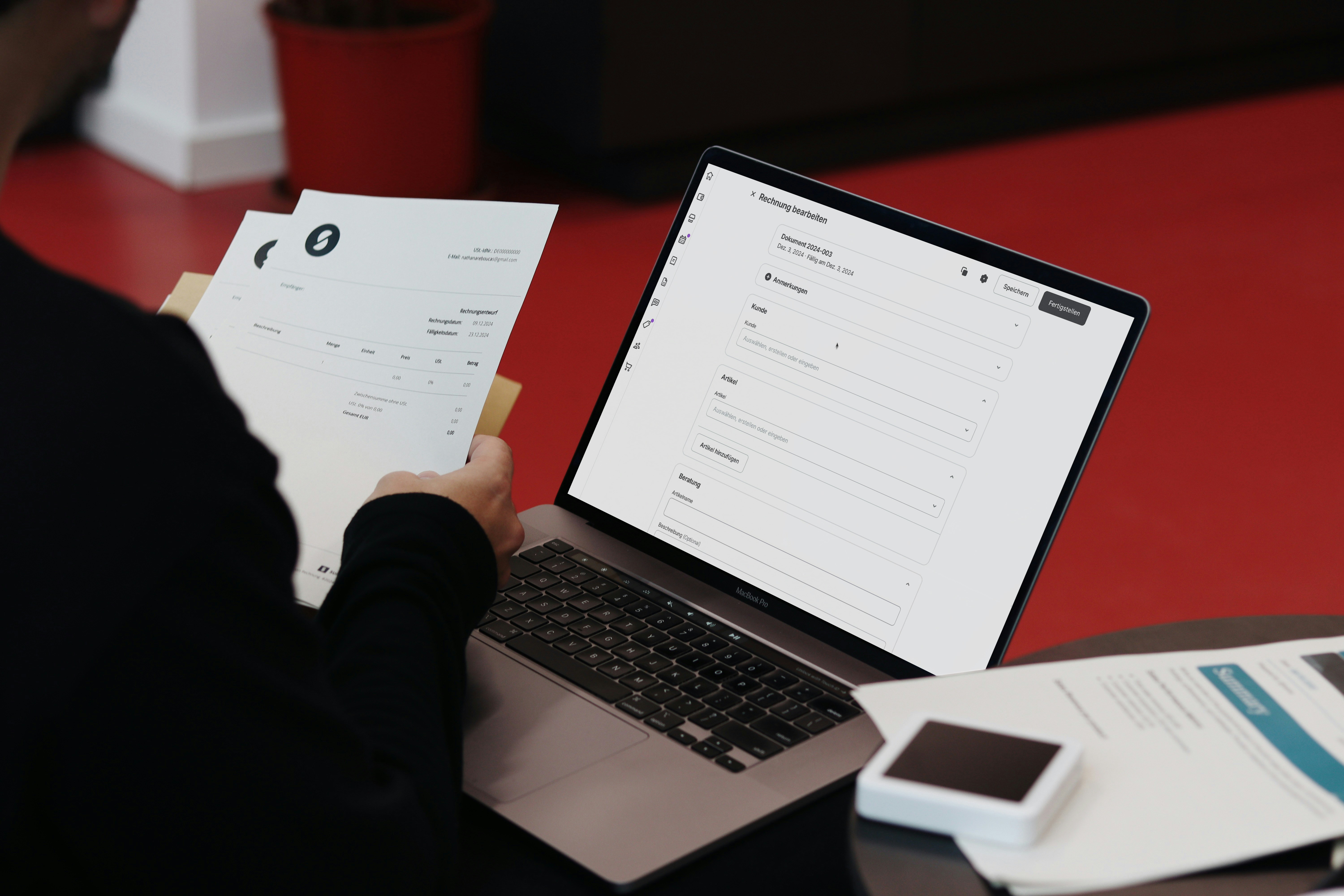
A clear, practical guide to SME invoicing in Spain in 2025-2026: what must be on every invoice, what is changing with e-invoicing and Verifactu, VAT rules, legal payment terms, and the tools SMEs should use. You will learn how to issue compliant invoices fast, including simplified invoices, when to send e-invoices via FACe, and how to handle cross-border sales. We also cover deadlines: Jan 1, 2026 for companies and Jul 1, 2026 for sole traders and the rest for Verifactu compliance, plus the expected B2B e-invoicing rollout under the Crea y Crece law. Finally, a no-nonsense checklist to choose an SME billing platform that is Spain-ready.
Quick Q&A
What is SME invoicing in Spain? Issuing legal invoices for goods or services, getting paid, and keeping VAT books according to Spanish rules.
When is Verifactu mandatory? From Jan 1, 2026 for corporates and Jul 1, 2026 for the rest of businesses.
Do I need to send e-invoices to the public sector? Yes. Use Facturae 3.2.2 and send through FACe when billing the Administration.
Which VAT rates apply in 2025? 21% general, 10% reduced, 4% super-reduced.
SME invoicing (quick win)
SME invoicing in Spain means creating compliant invoices, collecting payment, and recording VAT so your books match what Hacienda expects. Think of it as three steps: make the invoice, get the money, and keep evidence you can show in an audit.
The fastest path for a typical SME is this: set up invoice series, add your tax data, NIF and address, choose a default VAT rate, and default payment terms like 30 days. Add bank details, IBAN and a QR or payment link, and save branded templates. That is your daily setup.
SME billing (what it includes and how to structure it)
SME billing is the end-to-end process from quotes to payment and ledger. It covers invoices, credit notes, reminders, and VAT reporting.
- Quotes and estimates should be accepted and then converted to an invoice.
- Delivery notes, called albaranes, go out when physical goods ship. Map each albaran to the invoice line so quantities match.
- Recurring billing is for subscriptions or maintenance. Set a calendar and let the system create invoices automatically.
- Deposits and advance payments need an advance invoice. VAT accrues when you collect the deposit, not only on final delivery.
- Credit notes, or facturas rectificativas, correct price, quantity, VAT, or cancellations. They always reference the original.
- Series and numbering must be unique, chronological, and sequential per series. Use separate series for different lines, locations, or online vs retail.
- Collections should be simple: payment links for cards, SEPA transfers, direct debit, and Bizum or TPV where relevant. Send polite reminders.
- Reporting means a VAT book, a sales ledger, and customer aging. Export SAF-T or CSV if an auditor or your advisor asks.
Tip: if you want an all-in-one workflow, start with an online accounting platform that fits SMEs.
Legal invoice requirements (Spain)
Every invoice must include the mandatory fields set in the Spanish Invoicing Regulation. Full and simplified invoices follow different levels of detail, but all must use correlatively numbered series.
A full invoice must show
The invoice number and series, the date of issue and supply, the seller and buyer legal name, the NIF or VAT number and addresses, a clear description, the taxable base, the VAT rate or rates and amounts, the total, and any special mentions when they apply. Examples are reverse charge, exemption article, intra-EU supply, or margin schemes.
A simplified invoice, often called a ticket, is allowed mainly up to 400 euros VAT included or in specific cases
It has fewer fields, but must include number and series, date, seller NIF and name, a description, the VAT rate or a note that VAT is included, and the total. Add the buyer NIF and address if they need deduction.
Series management means at least one default series
Keep separate series for returns and rectifications, e-commerce, or different establishments.
Record-keeping is mandatory
Keep invoices in order and accessible. The tax statute of limitations is 4 years. Commercial record-keeping is usually 6 years, so keep both periods.
For the legal text, see the Invoicing Regulation in the BOE. Official reference.
Credit notes and rectifications
Issue a rectifying invoice when the original had errors in data, base, or VAT, or when a return or discount occurs. Always reference the original invoice number or numbers.
Rectification can show the delta amounts or the corrected totals. Issue the rectification as soon as you are aware and within the 4 year window.
Proformas and quotes
Proforma invoices and quotes have no fiscal validity. They do not replace the final invoice. Always issue the official invoice once the sale is confirmed or payment is taken, especially for deposits.

Electronic invoicing and Verifactu (2025-2026)
Two parallel tracks matter to SMEs. The first is Verifactu, also called SIF rules for invoicing systems. The second is mandatory B2B e-invoicing under the Crea y Crece law.
Verifactu timing is clear. Companies subject to Corporate Income Tax must comply from Jan 1, 2026. The rest of businesses, including sole traders, must comply from Jul 1, 2026. Invoices must include a QR and, where applicable, the legend that the invoice is verifiable under Verifactu.
Who is excluded from SIF and Verifactu. Taxpayers who report their own invoices via SII, the Immediate Supply of Information, are excluded. Some sector specifics apply.
B2B e-invoicing under Crea y Crece will be phased. The final calendar depends on the royal decree regulation. Guidance points to larger firms first, those with at least 8 million euros in turnover, and later the rest. Check for any official update before you publish or sign contracts.
Public sector e-invoice is already here. Use Facturae 3.2.2 and submit through the FACe portal when billing the Administration. Your software must export Facturae that passes FACe validations.
Practical setup. Confirm your software is AEAT compliant for Verifactu, can generate the QR and an audit trail, and supports Facturae and FACe for public clients. A cloud billing platform makes this simpler.
VAT on SME invoices, IVA
Apply standard VAT rules. Spain has a general VAT rate of 21%, a reduced rate of 10%, and a super-reduced rate of 4% for specific goods and services. In 2025 some temporary cuts ended, so check your items.
Typical SME cases. Services and consulting use 21%. Hospitality and catering use 10% in many cases. Books and newspapers can be 4% if eligible. Flowers and plants often use 10%. Funeral service parts can be 21%.
Recargo de equivalencia. If your buyer is a retail trader under this regime, invoices must include VAT and the surcharge. Confirm the current rates for 2025 with your advisor.
Advance payments. VAT accrues when you receive the deposit. Issue an advance invoice then.
Exemptions and special mentions. Education and health have exemptions. Use the reverse charge text for construction, scrap, telecoms, and for B2B non-established supplies. For intra-EU supplies include the reference to the directive article or the reverse charge wording.
Payment terms and late payment in SME contracts
Default rule. If there is no term agreed, payment is due 30 calendar days from delivery or service. In B2B contracts, payment terms cannot exceed 60 days. In the public sector the term is 30 days from invoice approval.
Interest for late payment in commercial transactions. Use the legal commercial interest published by the Treasury in the BOE. For 2025 it is 11.15% for the first half and 10.15% for the second half. You may also recover reasonable recovery costs.
Practical clause for invoices or contracts. Payment due in X days. Late payments accrue the legal commercial interest plus recovery costs as permitted by Law 3/2004.
Tip to speed up cash. Enforce onboarding with purchase order numbers and an acceptance workflow. For recurring services, set up SEPA direct debit. A cafe we work with cut late payments by half after adding PO numbers.
Cross-border invoicing, EU and beyond
Intra-EU B2B supplies. Do not charge Spanish VAT if both parties have valid EU VAT numbers. Include your customer VAT ID and a reverse charge mention. File the model 349. Verify VAT IDs in VIES.
Intra-EU services general rule for B2B. Tax at the customer country. Invoice without VAT and add the reverse charge text.
Exports outside the EU. They are generally exempt with proof of export.
B2B supplies in Spain by non-established suppliers. The reverse charge often applies. Include the right mention so the buyer accounts for VAT.
If your buyer is under recargo de equivalencia, include the surcharge on your invoice even for cross-border cases when the rule says so.
For detailed rules on self-employed, see mandatory electronic invoice for self-employed.
SME billing software checklist, Spain-ready
Must-have compliance features.
- SIF and Verifactu readiness. QR on invoices, an immutable audit trail, and export of record formats that match the 2026 timelines.
- Facturae 3.2.2 export and FACe sending for public clients. Support attachments like PDF and XML and track acceptance statuses.
- Numbering series control. Credit notes that link to originals. Advance invoices and recurring invoices.
- A VAT engine with 21%, 10%, and 4% rates. It must handle exemptions, reverse charge, and recargo de equivalencia.
- A customer ledger with aging and dunning. SEPA and PSD2 payment links.
- Data retention and retrieval for 4 and 6 years. CSV and XML exports.
Nice to have. OCR for expense capture, multi-currency, a mobile app, project and time tracking, and quotes to invoice workflows.
Buyer guide angle. Prioritize tools that advertise AEAT compliance for Verifactu and Spanish public e-invoicing support, Facturae and FACe. Do not trust a generic e-invoice label.
If you want less admin, renn automates bookkeeping and tax filing for SMEs, with Spain-ready invoicing. It means less tax, more take-home, and hours saved each month.
Bottom line
From 2025-2026, Spanish SMEs should lock in compliant invoicing. Use the correct fields, the correct VAT, and QR-enabled invoices under Verifactu by the 2026 deadlines. Use software that can output Facturae for public clients. Keep terms under 60 days, use reverse charge and VIES correctly for EU deals, and standardize series and rectifications.
The result is fewer rejections, faster payments, and audit-proof records. Pick a system that handles SME invoicing end to end so you can focus on work, not admin.





